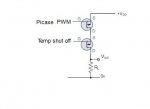I'm using the PWM output on the picaxe08M2 at 4.5khz flowing about 18mA. The PWM pin on the Picaxe goes to the source of a PNP FET and the drain to the load. The gate of the FET goes to a inverter that is connected to a temperature switch with an open drain output that is pulled up. When the temp gets too high and the temp switch triggers, it goes low, then inverter sends the high signal to the gate of the PNP and turns off the PWM output.
Everything works fine, except now I would like to draw more than 20mA from the PWM pin, so I want to find a way for the Picaxe to send the PWM signal to the gate of a FET and still retain the temperature shutdown capability. I need to amplify the current from the pull up resistor on the temp switch to supply ~30mA, which will go to the source of the PNP, the drain to the load, and the gate controlled by the Picaxe, which will invert the PWM signal, but I can fix that in the code pretty easily.
My question is about how easiest to go about this? I've never implemented a BJT or MOSFET as an amplifier before, but I've been reading about common collector and common drain amplifiers, of which either should likely work? Possibly the common collector being better at lower voltage. If I use a common collector amplifier, when the temp switch goes low, can the base of the BJT be connected directly to ground or should I put a resistor in between?
Or possibly is there some kind of amplifier chip like this schmitt trigger inverter I having been using? http://www.ti.com/lit/ds/symlink/sn74lvc1g14.pdf
The exact same thing with an amplified output instead of an inverted one would be perfect, even though it's only 24mA, I could live with that. Then I wouldn't have any voltage drop like I would with a BJT.
I can make a circuit diagram if anything is unclear. Any suggestions about the best way to proceed?
Everything works fine, except now I would like to draw more than 20mA from the PWM pin, so I want to find a way for the Picaxe to send the PWM signal to the gate of a FET and still retain the temperature shutdown capability. I need to amplify the current from the pull up resistor on the temp switch to supply ~30mA, which will go to the source of the PNP, the drain to the load, and the gate controlled by the Picaxe, which will invert the PWM signal, but I can fix that in the code pretty easily.
My question is about how easiest to go about this? I've never implemented a BJT or MOSFET as an amplifier before, but I've been reading about common collector and common drain amplifiers, of which either should likely work? Possibly the common collector being better at lower voltage. If I use a common collector amplifier, when the temp switch goes low, can the base of the BJT be connected directly to ground or should I put a resistor in between?
Or possibly is there some kind of amplifier chip like this schmitt trigger inverter I having been using? http://www.ti.com/lit/ds/symlink/sn74lvc1g14.pdf
The exact same thing with an amplified output instead of an inverted one would be perfect, even though it's only 24mA, I could live with that. Then I wouldn't have any voltage drop like I would with a BJT.
I can make a circuit diagram if anything is unclear. Any suggestions about the best way to proceed?





